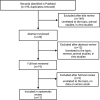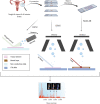Mass spectrometry imaging in gynecological cancers: the best is yet to come
- PMID: 36536419
- PMCID: PMC9764543
- DOI: 10.1186/s12935-022-02832-3
Mass spectrometry imaging in gynecological cancers: the best is yet to come
Abstract
Mass spectrometry imaging (MSI) enables obtaining multidimensional results simultaneously in a single run, including regiospecificity and m/z values corresponding with specific proteins, peptides, lipids, etc. The knowledge obtained in this way allows for a multifaceted analysis of the studied issue, e.g., the specificity of the neoplastic process and the search for new therapeutic targets. Despite the enormous possibilities, this relatively new technique in many aspects still requires the development or standardization of analytical protocols (from collecting biological material, through sample preparation, analysis, and data collection, to data processing). The introduction of standardized protocols for MSI studies, with its current potential to extend diagnostic and prognostic capabilities, can revolutionize clinical pathology. As far as identifying ovarian cancer subtypes can be challenging, especially in poorly differentiated tumors, developing MSI-based algorithms may enhance determining prognosis and tumor staging without the need for extensive surgery and optimize the choice of subsequent therapy. MSI might bring new solutions in predicting response to treatment in patients with endometrial cancer. Therefore, MSI may help to revolutionize the future of gynecological oncology in terms of diagnostics, treatment, and predicting the response to therapy. This review will encompass several aspects, e.g., contemporary discoveries in gynecological cancer research utilizing MSI, indicates current challenges, and future perspectives on MSI.
Keywords: Cancer research; Endometrial cancer; Mass spectrometry imaging; Ovarian cancer; Vulvar cancer.
© 2022. The Author(s).
Conflict of interest statement
The authors declare that they have no known competing financial interests or personal relationships that could have appeared to influence the work reported in this paper.
Figures



References
-
- Boggess JF, Kilgore JE, Tran AQ. Uterine cancer. Abeloff’s Clin Oncol. 2021 doi: 10.1016/B978-0-323-47674-4.00085-2. - DOI
Publication types
LinkOut - more resources
Full Text Sources
Research Materials

